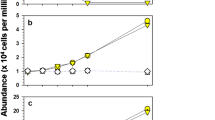Summary
The effects of the new antibiotic netilmicin (NT) were studied onEuglena gracilis green cells. It was found that, in the presence of the drug, chlorophyll synthesis was strongly inhibited and plastid structure dramatically altered as revealed by fluorescence and electron microscopic observations. Importantly, NT at low concentrations (10–20 Μg/ml) and for short periods of time (36–72 hours) induced a marked bleaching effect that was permanent and accompanied by the persistence in the colorless cells of poorly differentiated plastids. Other cell components were not influenced as shown by their appearance and also by the kinetics of growth and the cell viability. On the basis of the results and of the literature on the bleaching agents it is suggested that NT is an untoxic antibiotic which specifically inhibits protein synthesis at prokaryotic level.
Similar content being viewed by others
References
Barza, M., Lauermann, M. W., Tally, F. P., Gorbach, S. L., 1980: Prospective, randomized trial of netilmicin and amikacin, with emphasis on eighth-nerve toxicity. Antimicrob. Agents Chemother.17, 707–714.
Ben-Shaul, Y., Marcus, Y., 1969: Effects of chloramphenicol on growth, size distribution, chlorophyll synthesis and ultrastructure ofEuglena gracilis. J. Cell Sci.4, 627–644.
Bock, B. V., Edelstein, P. H., Meyer, R. D., 1980: Prospective comparative study of efficacy and toxicity of netilmicin and amikacin. Antimicrob. Agents Chemother.17, 217–225.
Dhawan, V., Marso, E., Martin, W. J., Young, L. S., 1977:In vitro studies with netilmicin, compared with amikacin, gentamicin and tobramycin. Antimicrob. Agents Chemother.11, 64–73.
Ebringer, L., 1970: The action of nalidixic acid onEuglena plastids. J. gen. Microbiol.61, 141–144.
—, 1972: Are plastids derived from prokaryotic micro-organisms? Action of antibiotics on chloroplasts ofEuglena gracilis. J. gen. Microbiol.71, 35–52.
Engle, J. E., Abt, B. T., Schenck, D. W., Schoolwerth, A. C., 1979: Netilmicin and tobramycin: comparison of nephrotoxicity in dogs. Invest. Urol.17, 98–102.
Fasulo, M. P., Bassi, M., Dall'Olio, G., 1981: Effects of erythromycin onEuglena gracilis as a model for testing the toxicity of antibacterial drugs. Arzneim.-Forsch./Drug Res.31, 1869–1872.
—,Vannini, G. L., Bruni, A., Mares, D., 1976: Physiological and ultrastructural changes induced in light-grown cells ofEuglena gracilis by myomycin treatment. Z. Pflanzenphysiol.80, 407–416.
——,Mares, D., 1979: The regreening of a myomycin-bleached strain ofEuglena gracilis: structural and functional analysis. Protoplasma101, 301–315.
Herting, R. L., Lorber, R. R., Miller, M., Danzig, M. R., 1981: Multicenter comparative evaluation of netilmicin and gentamicin in adult patients. Efficacy and safety. Arzneim.-Forsch./Drug Res.31, 366–370.
Kivic, P. A., Vesk, M., 1974: An electron microscope search for plastids in bleachedEuglena gracilis and inAstasia longa. Can. J. Bot.52, 695–699.
Lyman, H., 1967: Specific inhibition of chloroplast replication inEuglena gracilis by nalidixic acid. J. Cell Biol.35, 726–730.
Mego, J. L., 1964: The effect of hadacidin on chloroplast development in non-dividingEuglena cells. Biochim. biophys. Acta79, 221–225.
Nicolas, P., 1981: Sensitivity ofEuglena gracilis to chloroplastinhibiting antibiotics, and properties of antibiotic-resistant mutants. Plant Sci. Lett.22, 309–316.
Schaad, U. B., McCracken, Jr., G. H., Loock, C. A., Thomas, M. L., 1980: Pharmacokinetics and bacteriological efficacy of moxalactam (LY 127935), netilmicin, and ampicillin in experimental Gram-negative enteric bacillary meningitis. Antimicrob. Agents Chemother.17, 406–411.
Schwartzbach, S. D., Schiff, J. A., 1974: Chloroplast and cytoplasmic ribosomes ofEuglena selective binding of dihydrostreptomycin to chloroplast ribosomes. J. Bacteriol.120, 334–341.
Szot, R. J., McCornick, G., Chung, M., Christie, B., Weinberg, E., Schwartz, E., 1980: Comparative toxicity of netilmicin and tobramycin in dogs. Toxicol. Appl. Pharmacol.55, 169–178.
Vannini, G. L., Fasulo, M. P., Bruni, A., Dall'Olio, G., 1978: Structural and developmental aspects during the greening process ofEuglena gracilis treated with myomycin. Protoplasma96, 335–349.
Wright, J. J., 1975: Synthesis of I-N-ethyl sisomicin: a broadspectrum semi-synthetic aminoglycoside antibiotic. J. Chem. Commun.6, 206–209.
Author information
Authors and Affiliations
Additional information
This work was supported by a grant from Italian Research Council (CNR), Contract N. 82.02016.04.
Rights and permissions
About this article
Cite this article
Fasulo, M.P., Bonora, A. Indications about the mechanism of action and toxicity of netilmicin on the basis of the antiplastidial activity inEuglena gracilis . Protoplasma 119, 31–34 (1984). https://doi.org/10.1007/BF01287814
Received:
Accepted:
Issue Date:
DOI: https://doi.org/10.1007/BF01287814




